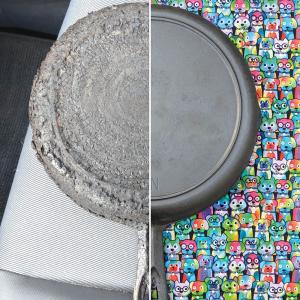2024 - Volume #48, Issue #3, Page #30
[ Sample Stories From This Issue | List of All Stories In This Issue | Print this story
| Read this issue]
How To Remove Rust From Cast Iron Pans
 |
Writing books about cast-iron cookware wasn’t on her radar when she started using a pan by Birmingham Stove & Range that had been given to her by her mother-in-law several years ago. She wasn’t sure how to care for cast iron but quickly learned after she threw out her nonstick pans due to health concerns.
“I found out how advantageous cast iron is; it gives you iron in food, and I’ve always been anemic. I felt excited, like I was cooking for the first time, and challenged myself to see if I could make everything in cast iron,” Jones says.
When she attended a publisher/writer event in New York to pitch her faith-based writing, a conversation with a representative of Red Lightning Books (an imprint of Indiana University Press) about her passion for cast iron landed her first book assignment: “Modern Cast Iron: The Complete Guide to Selecting, Seasoning, Cooking, and More.”
Between her own experience and interviewing collectors and restorers for “Skilletheads,” she provides information about seasoning cast iron (the right blend of oil and heat) to cleaning it (yes, it’s OK to wash with dish detergent) to removing rust.
“For anyone who has cast iron, rust can happen, like when you leave a wet lid on the pan. If it’s minor you need to take care of it before the rust takes over,” she says. A wool scouring pad, liquid dish detergent, and elbow grease may solve the problem.
When the rust is more severe, vinegar baths (no longer than an hour or two to prevent pitting the iron) or chemical-based products such as Easy Off oven cleaner can be used. Sanders and other tools also work but should never be used on valuable cast iron cookware.
For items with encrusted rust, electrolysis is often the best option. Jones explains how to make an E-Tank in her book using a garbage can, rebar, steel wire, wooden board, and a manual car battery charger.
“Make sure the container is big enough (for the pan) but small enough to be effective with the sacrificial anodes (rebar) near it without touching it,” she says. Once it’s been filled with water and the charger turned on between 2 and 10 amps, the red rust will usually fall off in 24 hrs. or less.
Since electrolysis is only a rust reduction process, the remaining black rust must be scrubbed off, down to the shiny metal, and the pan seasoned in the oven for at least an hour.
Proper seasoning is chemistry, Jones says, and it needs to be done correctly with the right amount of oil and heating the pan to temperatures 20 degrees less than the smoke point of the oil used. She includes a list of smoke points in her book “Modern Cast Iron.” But for details on restoration, as well as recipes, check out “Skilletheads.”
“Don’t ever throw cast iron away. Give it to someone who can use it or send it to a restorer. Every piece of cast iron is a piece of history, especially when it was Grandma’s,” she says. “The nostalgia part about cast iron is big. It’s part of gathering around the table. There’s lots of interest, and I’m proud to be a small part of that.”
Her books are available at Amazon, Barnes & Noble, and other bookstores and online.
Contact: FARM SHOW Followup, Ashley Jones (ashkirbyjones@gmail.com; www.BigSisterKnows.com).

Click here to download page story appeared in.

Click here to read entire issue
To read the rest of this story, download this issue below or click here to register with your account number.




